Chiniquodon Huene (Therapsida, Cynodontia) in the Triassic of Ischigualasto, Argentina
Considerations about its family allowance
Keywords:
Paleontology, Therapsida, Cynodontia, Chiniquodon, mandibular morphology, taxonomy, Triassic, Ischigualasto, ArgentinaAbstract
From the Ischigualasto beds of Argentina, three fragments of the anterior region of the skull, one of them with mandible, are described and figured. They are assigned to Chiniquodon Huene and the diagnosis of the genus is given as follows: advanced carnivorous Cynodont with short and massive muzzle, with secondary palate reaching the last posteanine tooth; 4 small incisors separated by a long diastem from the canine; rows of upper postcanine teeth diverging backwards, with 7 or 8 sectorial teeth, the anterior ones less oval than the posterior ones, these laterally compressed and with a principal cusp formed by the anterior edge of the tooth; pronounced postcanine constriction of the maxilla; deep paracanine fossae and pronounced lateral depressions running along the secondary palate. Three small mandibular incisors without diastem 6 to 8 mandibular postcanines laterally compressed. Mandibular simphysis low and long.
Some comparisons are made with the Thrinaxodontidae from the Cynognathus zone, particularly with Symphinctostoma, to conclude that Watson & Romer?s assignation of the genus to Cynognathidae apparently does not agree with the principal characters of Chiniquodon. Instead, the affinities are more clear with Thrinaxodontidae. Thus, the author accepts Huene?s idea of including Chiniquodon in a separate family. This family would be related to Thrinaxodontidae.






